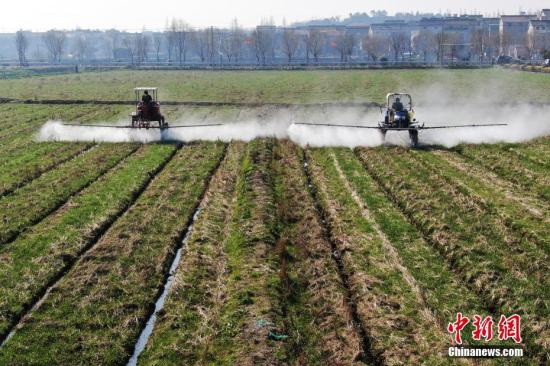China News Service, April 17th. National Bureau of Statistics spokesman Mao Shengyong said on the 17th that the current agricultural production situation is good, and grain prices are generally stable.
On the morning of the 17th, the State Council Office held a press conference on the operation of the national economy in the first quarter of 2020. A reporter asked: The added value of the first industry fell by 3.2% in the first quarter. What is the reason? Does it mean that the agricultural production situation is not so optimistic, and many people have been in Tunliang before, is this necessary?
On February 20th, in the modern agriculture demonstration zone on Nanjing Hushu Street, staff drove a self-propelled sprayer to spray herbicides on wheat. Photo by Tuobo
Mao Shengyong responded that the added value of the first industry declined in the first quarter, mainly due to the drag of the livestock industry. Due to the impact of the early African swine fever epidemic, the production of live pigs has improved month-on-month, but it has declined year-on-year. In the first quarter, pork production fell by 29.1% year-on-year. Due to the impact of the recent epidemic, the slaughter of pigs, cattle, sheep and poultry has been affected to a certain extent. The total output value of animal husbandry in the first quarter fell by 10.6%, and the animal husbandry accounted for about 45% of the entire primary industry in the first quarter, so the primary industry was lower Value added speed.
In addition, the agricultural production situation is good. Judging from the current situation, spring tillage and spring sowing have proceeded in an orderly manner, and have not been affected by the epidemic. Winter wheat, which accounts for more than 90% of summer grains, is currently gaining good momentum. According to the survey, the area of grain intended to be planted in some major grain-growing provinces across the country has continued to grow, which has also changed the situation in the past. Taken together, these conditions, together with the current agricultural production conditions and the overall favorable agricultural production situation, have also created relatively good conditions for the annual grain harvest.
Also, the current grain prices are generally stable. In the past five years, grain output has been above 1.3 trillion catties. In 2019, grain output reached a record high. Now China ’s grain self-sufficiency rate is very high, and its stocks are still abundant. From the perspective of grain supply and demand, the impact of the epidemic in the first quarter was so great that grain prices remained generally stable, and prices in some key epidemic areas, including Wuhan, did not fluctuate significantly. In the first quarter, grain prices rose by 0.6% year-on-year. If viewed from March, grain prices rose by 0.7% year-on-year, both of which rose slightly and remained flat.
"This aspect shows that China's food supply capacity is strong, on the other hand, it shows that the market supply and demand relationship is generally stable. Therefore, from this perspective, it is no problem to hold the rice bowl firmly in its own hands." Mao Shengyong said.
Mao Shengyong said that in terms of animal husbandry, the production of pork, especially livestock, including livestock is accelerating. With the advancement of resumption of production and production, especially a series of policies to promote the production of hogs in the early stage, the policy has continued to take effect. The production of hogs is improving and the recovery is accelerating. From the end of the first quarter, the inventory of live pigs increased by 3.5% compared with the end of the previous year, of which the number of fertile sows increased by 9.8%, which was a quarter-on-quarter increase for two consecutive quarters. Therefore, the entire livestock industry is accelerating recovery and improvement.

